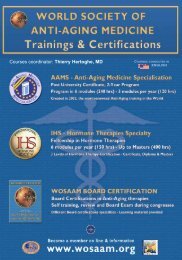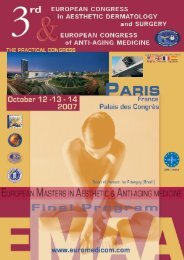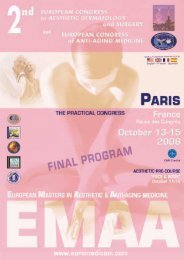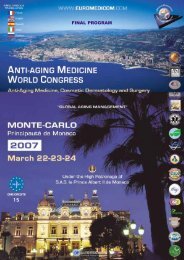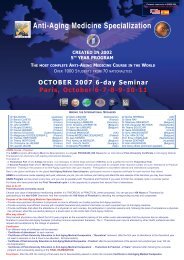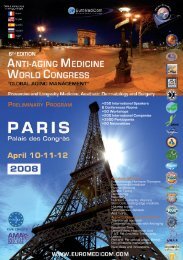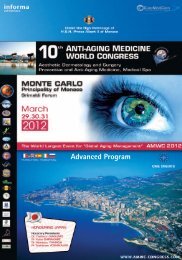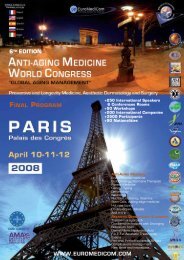FINAL PROGRAM 6TH EDITION - EuroMediCom
FINAL PROGRAM 6TH EDITION - EuroMediCom
FINAL PROGRAM 6TH EDITION - EuroMediCom
You also want an ePaper? Increase the reach of your titles
YUMPU automatically turns print PDFs into web optimized ePapers that Google loves.
NEW CANCER POLYMORPHISM TO SPOT AND IMPROVE ANTI-AGING THERAPIESLE NOUVEAU POLYMORPHISME DU CANCER POUR DÉCOUVRIR ET AMÉLIORER LES THÉRAPIES ANTI-ÂGEHELENA BARANOVA(FRANCE)Recent progress in genetics and genomics opens new opportunities for clinical usage of genetic data. However, despite tremendousnumber of studies and publications only around 4 % of all obtained results can be considered as clinically reliable and possible totransfer to practice.This presentation is focused on the recent achievements in relation to genetics of cancer, the necessity of EBM (evidence basedmedicine) usage and possible practical outcome. Special attention is paid to understanding of deference and management strategiesfor inherited and environmentally induced cancers. Prostate cancer example will be demonstrated.Furthermore, epigenetics and epigenomics impacts in cancer development and management are particularly highlighted.New possibilities for personalized prevention approaches based on recent genomics achievements are especially discussed.Finally, modern vision of aging through genomics will be presented, including the new therapeutic opportunities for anti-aging medicine.THE CANCER IS A FUNGUSLE CANCER EST UN CHAMPIGNONTULLIO SIMONCINI(ITALY)From about 100 years the theory on cancer is based on the hypothesis that there is a malfunctioning of the genes. This point of viewimplies that the cancer is an intracellular fact.On the contrary, my point of view is that cancer is an infection, a fungal infection, that is an extracellular phenomenon.As in the world of the plants, where the cancer is due to a fungal invasion, it is possible to argue the same thing for the human beings.Fungi are always involved in the cancer and they are found in vivo and in the post-mortem examination, but scientists think that theycome on just after the illness. My opinion is that they come before, produce the cancer, blunt the immune system then invadecompletely the organism.Every kind of cancer is caused by candida species fungi and the histology configuration is the defence reaction of a tissue againsttheir invasion. By the time, the tissue gets exhausted and produces only undifferentiated cells.The cancer could be named a "solid abscess" where the colonies are inside and host cellular reaction is all around.Usual antifungal drugs are ineffective in the tumours because the solid colonies can be attacked only on the surface of their volume,and after the first administrations they become resistant.A solid infection is much more powerful than a bacterial one, that's why simple fungal infections can last forever.At the moment the only substance that I found, able to penetrate the volumetric infections is the sodium bicarbonate for the cancer ofinternal organs; for skin cancer the iodine tincture (peculiarly spread on) is the best substance to eliminate themThere are many works that show the effectiveness of sodium bicarbonate on cancer, but their conclusion are wrong because theyassume an intracellular action, instead of an antifungal one.It takes more than 20 years that I cured people with my method and many patients healed completely from cancer even in the casesthe official oncology gave up. Many videos in my website www.cancerfungus.com show many patients that are testimonial of theeffectiveness of my therapy.The best way to try to eliminate a tumour is to put it in contact with sodium bicarbonate as close as possible, with oral administrationfor the digestive tract, with enema for the rectum, with washing out for the vagina and uterus; intravenously for the lung and the brain,with inhalation for the upper airways.Breast, lymph nodes and under skin lumps can be treated with local perfusions.The internal organs can be treated with sodium bicarbonate by locating suitable catheters in their arteries (liver, pancreas, prostate,limbs) or in the cavities (pleura, peritoneum).It is important to treat every kind of cancer with the right dosage, 500 cc 5% or 8,4% for the administrations in vein, artery and in thecavities.Every treatment has to consider that tumour colonies regress from the 3dh to the 4th day and collapse from the 4th to the 5th day, sothat a 6 day administration is enough.A complete effective cycle is made of 6 days on 6 days off treatment, repeated 4 times.The most important side effects of this care system are thirst and tiredness.In conclusion, sodium bicarbonate is really effective against the tumours and harmless as well, it should always administered to everycancer patient.ANTI-AGING MEDICINEDOES TESTOSTERONE CAUSE PROSTATE CANCER? THE EVIDENCE PRO AND CONTRALA TESTOSTERONE CAUSE-T-ELLE LE CANCER DE LA PROSTATE ? LES PREUVES POUR ET CONTREPETER LIM(SINGAPORE)When aging men receive testosterone replacement therapy (TRT), the primary concern is prostate safety especially the possibility ofstimulating prostate cancer. Although TRT results in modest elevations in prostate specific antigen (PSA) and minor changes inhaematocrit & urinary flow parameters, "there is no evidence that normal levels of testosterone promote the development of cancer ofthe prostate".However, it is clear that the administration of testosterone enhances a pre-existing prostatic malignancy. Since instances of prostatecancer in men receiving TRT reported in the past, careful monitoring for prostate disease is considered mandatory for men on TRT.This is currently our traditional view. Is there anything new to challenge our concepts pertaining to safety issues in TRT?Feneley and Carruthers recently reviewed 1500 hypogonadal men with a mean age of 54 years. Twelve had an abnormal PSA orabnormal DRE at screening and were found to have cancer. And of the rest, only seven in 2100 man years of follow up were diagnosedwith prostate cancer based on a change in PSA, or rectal examination-and all 7 of these had clinically localized disease.121




